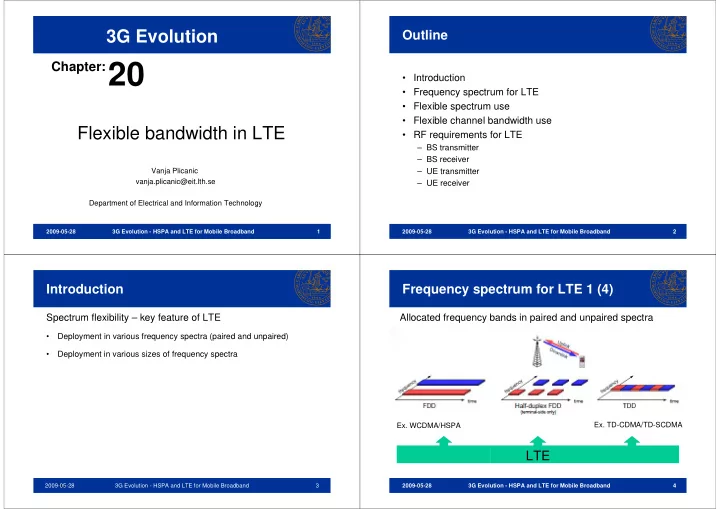

3G Evolution Outline Chapter: 20 • Introduction • Frequency spectrum for LTE • Flexible spectrum use • Flexible channel bandwidth use Flexible bandwidth in LTE • RF requirements for LTE – BS transmitter – BS receiver Vanja Plicanic – UE transmitter vanja.plicanic@eit.lth.se – UE receiver Department of Electrical and Information Technology 2009-05-28 3G Evolution - HSPA and LTE for Mobile Broadband 1 2009-05-28 3G Evolution - HSPA and LTE for Mobile Broadband 2 Rev Rev 1 1 Rev 2 Introduction Frequency spectrum for LTE 1 (4) Spectrum flexibility – key feature of LTE Allocated frequency bands in paired and unpaired spectra • Deployment in various frequency spectra (paired and unpaired) • Deployment in various sizes of frequency spectra Ex. TD-CDMA/TD-SCDMA Ex. WCDMA/HSPA LTE 2009-05-28 3G Evolution - HSPA and LTE for Mobile Broadband 3 2009-05-28 3G Evolution - HSPA and LTE for Mobile Broadband 4 Rev 3 Rev 4
Frequency spectrum for LTE 2(4) Frequency spectrum for LTE 3(4) • Reuse of frequency spectra for GSM and IMT-2000 • Additional ”new” frequency bands Paired spectrum - 450-470 MHz - 698-806 MHz - 2300-2400 MHz - 2500-2690 MHz - 3400-3600 MHz Unpaired spectrum Wide frequency operation range 450 MHz 3600MHz 2009-05-28 3G Evolution - HSPA and LTE for Mobile Broadband 5 2009-05-28 3G Evolution - HSPA and LTE for Mobile Broadband 6 Rev 5 Rev 6 Frequency spectrum for LTE 4(4) Flexible spectrum use Flexibility achieved if following considered: 3500 MHz band 450 MHz band 806-960 MHz band • Coexistence between operators in the same geographical area in the band • Co-location of BS equipment between operators • Coexistence with services in adjecent frequency bands and across country • Release independent frequency band principle Solution in RF requirements 2009-05-28 3G Evolution - HSPA and LTE for Mobile Broadband 7 2009-05-28 3G Evolution - HSPA and LTE for Mobile Broadband 8 Rev 7 Rev 8
Flexible channel bandwidth use 1(2) Flexible channel bandwidth use 2(2) Flexibility achieved with scalable bandwidth Solves the problem of spectrum availability and migration into currently used spectra (GSM, CDMA2000 etc.) Pure OFDM signal - Bandwidths 1.4 MHz and 3 MHz used 90% of the channel bandwidth (78% for 1.4 MHz case) Set of bandwidths frequency band dependent 2009-05-28 3G Evolution - HSPA and LTE for Mobile Broadband 9 2009-05-28 3G Evolution - HSPA and LTE for Mobile Broadband 10 Rev 9 Rev 10 RF requirements for LTE BS transmitter requirements 1(2) • BS and UE requirements for transmit and receive Unwanted emissions: performance - Out-of-band (OOB) emissions – Transmitter characteristics: maximum output power, output power - Spurious emissions dynamics, transmitted signal quality, unwanted emissionstranmitter Concept of operating band unwanted emissions intermodulation – Receiver characteristics: reference sensitivity level, receiver dynamic range , Adjecent Channel Selectivity, receiver blocking, receiver intermodulation, receiver spurious emissions • Flexibility in bandwidth considered • Regional regulation – Network signaling of RF requirements for UE – Europe: ETSI, ECC, US:FCC 2009-05-28 3G Evolution - HSPA and LTE for Mobile Broadband 11 2009-05-28 3G Evolution - HSPA and LTE for Mobile Broadband 12 Rev 11 Rev 12
BS transmitter requirements 2(2) BS receiver requirements 1(3) Adjacent Channel Leakage Ratio (ACLR) • Reference sensitivity – How much receiver degrades the SNR of the receiver signal – Defined over 25 resource blocks (5 MHz) From book “LTE, The UMTS Long Term Evolution” • Receiver dynamic range For analysis of coexistence between two systems that operate on - adjacent channels (OOB domain) – To ensure high throughput when receive signal is increased due to increased interference - Unwanted emissions from components at adjacent channel (PAs) 2009-05-28 3G Evolution - HSPA and LTE for Mobile Broadband 13 2009-05-28 3G Evolution - HSPA and LTE for Mobile Broadband 14 Rev 13 Rev 14 BS receiver requirements 2(3) BS receiver requirements 3(3) Receiver susceptibility to interfering signals Adjacent Channel Selectivity (ACS) ICS=In-channel selectivity ACS=Adjacent channel selectivity Adjacent Channel Interference Ratio (ACIR) + Receiver intermodulation 2009-05-28 3G Evolution - HSPA and LTE for Mobile Broadband 15 2009-05-28 3G Evolution - HSPA and LTE for Mobile Broadband 16 Rev 15 Rev 16
UE transmitter requirements 1(2) UE transmitter requirements 2(2) • UE power level Spectrum Emissions Mask (SEM) – Terminal power classes (23dBm) – Maximum Power Reduction (MRP) – Additional Maximum Power Reduction (A-MRP) • Unwanted emission limits – In-band emissions – OOB emissions • Spectrum Emissions Mask (SEM) • ACLR – Spurious emissions From book “LTE, The UMTS Long Term Evolution” 2009-05-28 3G Evolution - HSPA and LTE for Mobile Broadband 17 2009-05-28 3G Evolution - HSPA and LTE for Mobile Broadband 18 Rev 17 Rev 18 UE receiver requirements Summary • Assumptions: Various paired & unpaired frequency bands – 2 Rx antennas assumed, 0 dBi gain each + – Requirements on MRC combined signal Flexibel transmission bandwidth due to OFDM • Requirements – Similar to BS but different levels – Exception: no in-channel selectivity Spectrum flexibility in LTE …if considered properly in the physical layer and RF requirements 2009-05-28 3G Evolution - HSPA and LTE for Mobile Broadband 19 2009-05-28 3G Evolution - HSPA and LTE for Mobile Broadband 20 Rev 19 Rev 20
Recommend
More recommend